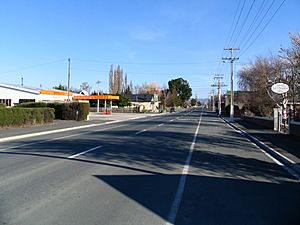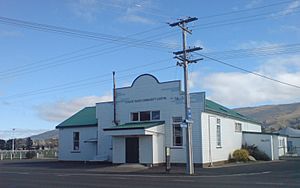Middlemarch, New Zealand facts for kids
Quick facts for kids
Middlemarch
|
|
|---|---|
|
Rural settlement
|
|

Looking south along State Highway 87 at Middlemarch
|
|
| Country | New Zealand |
| Region | Otago |
| District | Dunedin |
| Community board | Strath Taieri Community Board |
| Electorates |
|
| Area | |
| • Total | 1.05 km2 (0.41 sq mi) |
| Population
(June 2023)
|
|
| • Total | 160 |
| • Density | 152/km2 (395/sq mi) |
| Time zone | UTC+12 (NZST) |
| • Summer (DST) | UTC+13 (NZDT) |
| Postcode |
9597
|
| Area code | 03 |
| Local iwi | Ngāi Tahu |
Middlemarch is a small town in the Otago region of New Zealand's South Island. It sits at the bottom of the Rock and Pillar Range of hills. The town is in the wide Strath-Taieri valley, where the Taieri River flows.
Even though it's far away, Middlemarch is part of Dunedin city. This happened after local government changes in the late 1980s. The main part of Dunedin is about 80 kilometers to the southeast. Middlemarch is part of the Taieri voting area. Its Member of Parliament (MP) is currently Ingrid Leary. The town has a sewer system, but it doesn't have a public water supply. The weather is warm and dry in summer, and cold but dry in winter.
Middlemarch is an important town for the local farmers. It's also the end point of the Taieri Gorge Railway and the start of the famous Otago Central Rail Trail.
There are a few ideas about how Middlemarch got its name. One idea is that Mrs. Alice Humphreys named the town in 1876. She named it after a famous book called Middlemarch: A Study of Provincial Life by George Eliot. Another idea is that the name comes from an old English word, "march," which means a boundary or border area. So, Middlemarch could mean a middle area between two rivers. The name might also be linked to the Northumberland area in England. An early surveyor, John Turnbull Thomson, came from there, and there's a Middle March region in Northumberland.
Who Lives in Middlemarch?
Middlemarch is a small rural town. It covers about 1.05 square kilometers. As of 2018, about 153 people lived there. This means there were about 146 people for every square kilometer. Middlemarch is part of a bigger area called Strath Taieri.
In 2018, the population was 153 people. This was a small decrease from 2013 and 2006. There were 66 homes in the town. There were more males (81) than females (72). The average age of people in Middlemarch was 50.2 years. This is older than the national average of 37.4 years.
- About 14% of the people were under 15 years old.
- About 12% were aged 15 to 29.
- About 59% were aged 30 to 64.
- About 20% were 65 years or older.
Most people (96.1%) in Middlemarch are of European descent (Pākehā). About 21.6% are Māori. Some people identify with more than one ethnic group.
When asked about religion, most people (62.7%) said they had no religion. About 31.4% were Christian.
For those aged 15 and over, about 9% had a university degree or higher. About 23% had no formal school qualifications. The average income was $25,200. This was lower than the national average of $31,800. About 11% of people earned over $70,000.
Regarding jobs, about 39% of people aged 15 and over worked full-time. About 16% worked part-time, and 4.5% were unemployed.
Learning in Middlemarch
Strath Taieri School is the local school for students from Year 1 to Year 8. It's a co-educational school, meaning both boys and girls attend. The school opened in 1880. It started as a high school but became a primary school in 1975. As of 2024, there are 41 students.
Middlemarch Weather
Middlemarch has a varied climate. Here's a look at the weather:
| Climate data for Middlemarch (1991–2020 normals, extremes 2000–present) | |||||||||||||
|---|---|---|---|---|---|---|---|---|---|---|---|---|---|
| Month | Jan | Feb | Mar | Apr | May | Jun | Jul | Aug | Sep | Oct | Nov | Dec | Year |
| Record high °C (°F) | 37.4 (99.3) |
35.6 (96.1) |
32.6 (90.7) |
26.9 (80.4) |
25.3 (77.5) |
21.1 (70.0) |
18.4 (65.1) |
21.5 (70.7) |
24.7 (76.5) |
27.9 (82.2) |
31.2 (88.2) |
36 (97) |
37.4 (99.3) |
| Mean maximum °C (°F) | 32.1 (89.8) |
30.9 (87.6) |
29.0 (84.2) |
24.6 (76.3) |
20.7 (69.3) |
17.9 (64.2) |
16.6 (61.9) |
18.1 (64.6) |
22.1 (71.8) |
24.7 (76.5) |
27.1 (80.8) |
29.9 (85.8) |
33.6 (92.5) |
| Mean daily maximum °C (°F) | 22.5 (72.5) |
22.3 (72.1) |
20.6 (69.1) |
17.0 (62.6) |
12.9 (55.2) |
9.8 (49.6) |
9.5 (49.1) |
11.6 (52.9) |
14.7 (58.5) |
16.6 (61.9) |
18.5 (65.3) |
20.9 (69.6) |
16.4 (61.5) |
| Daily mean °C (°F) | 15.6 (60.1) |
15.2 (59.4) |
13.3 (55.9) |
10.2 (50.4) |
7.0 (44.6) |
4.4 (39.9) |
3.8 (38.8) |
5.7 (42.3) |
8.4 (47.1) |
10.1 (50.2) |
11.9 (53.4) |
14.3 (57.7) |
10.0 (50.0) |
| Mean daily minimum °C (°F) | 8.6 (47.5) |
8.1 (46.6) |
6.1 (43.0) |
3.4 (38.1) |
1.1 (34.0) |
−1.1 (30.0) |
−1.8 (28.8) |
−0.3 (31.5) |
2.1 (35.8) |
3.6 (38.5) |
5.4 (41.7) |
7.7 (45.9) |
3.6 (38.4) |
| Mean minimum °C (°F) | 1.8 (35.2) |
1.8 (35.2) |
−1.1 (30.0) |
−3.5 (25.7) |
−5.8 (21.6) |
−7.5 (18.5) |
−8.0 (17.6) |
−6.1 (21.0) |
−4.9 (23.2) |
−3.4 (25.9) |
−1.1 (30.0) |
0.8 (33.4) |
−8.5 (16.7) |
| Record low °C (°F) | −2.1 (28.2) |
−1.4 (29.5) |
−4.1 (24.6) |
−5.6 (21.9) |
−10.1 (13.8) |
−12.3 (9.9) |
−10.6 (12.9) |
−8.6 (16.5) |
−8.0 (17.6) |
−5.3 (22.5) |
−4.6 (23.7) |
−2.1 (28.2) |
−12.3 (9.9) |
| Average rainfall mm (inches) | 90.1 (3.55) |
70.2 (2.76) |
62.8 (2.47) |
65.0 (2.56) |
69.8 (2.75) |
57.3 (2.26) |
53.5 (2.11) |
53.1 (2.09) |
45.9 (1.81) |
73.8 (2.91) |
75.2 (2.96) |
76.7 (3.02) |
793.4 (31.25) |
| Mean monthly sunshine hours | 184.1 | 164.6 | 162.2 | 137.5 | 114.9 | 109.4 | 124.3 | 131.6 | 160.1 | 173.6 | 179.3 | 175.2 | 1,816.8 |
| Source: NIWA | |||||||||||||


